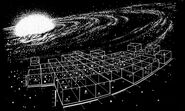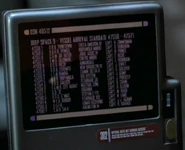(Adding categories) Tag: categoryselect |
No edit summary Tags: apiedit mobileedit |
||
| Line 47: | Line 47: | ||
According to ''[[Star Trek Maps]]'' (chart D), Organia had a moon called Sais. |
According to ''[[Star Trek Maps]]'' (chart D), Organia had a moon called Sais. |
||
| − | According to ''[[Star Trek: Star Charts]]'' (pp. 54, 57, 64) and the ''[[Stellar Cartography: The Starfleet Reference Library]]'' ("Stellar Cartography", p. 28, 30; "Federation Historical Highlights, 2161-2385"), Organia (Organia IV]] was a quarantined planet in the late [[24th century]]. The planet had no capital, and the dominant species were the noncorporeal Organians. Not much was |
+ | According to ''[[Star Trek: Star Charts]]'' (pp. 54, 57, 64) and the ''[[Stellar Cartography: The Starfleet Reference Library]]'' ("Stellar Cartography", p. 28, 30; "Federation Historical Highlights, 2161-2385"), Organia (Organia IV]] was a quarantined planet in the late [[24th century]]. The planet had no capital, and the dominant species were the noncorporeal Organians. Not much was known to the Federation about the population, the official government, and if the Organians had become warp capable and, if so, when. The Organia system was located in the [[Beta Quadrant]]. The [[star|primary]] was a [[Star Trek: Star Charts#Spectral classification|G-class star]]. This system was near the disputed border with the UFP ([[2152]]-2267). According to a map of the [[Klingon Empire]] – prepared by the Scribe K'Tark for the [[Klingon High Council]] in the [[Year of Kahless]] 893 ([[2366]]} – Organia was identified as a Klingon system. This claim was propagandistic, as the Empire claimed many border systems. This often put the Empire at odds with the Federation. |
==0=External link=== |
==0=External link=== |
||
Revision as of 18:07, 27 March 2016
AT: "xx" Organia was an inhabited M class planet near the Federation-Klingon border and the homeworld for the Organians, a non-corporeal species.
Location
In 2293, the location of Organia in the Milky Way Galaxy was labeled in the star chart "The Explored Galaxy", which was on display in Captain James T. Kirk's quarters aboard the USS Enterprise-A. (Star Trek VI: The Undiscovered Country, okudagram)
In 2371, the location of Organia was labeled in a star chart Data and Picard were studying in stellar cartography aboard the USS Enterprise-D. (Star Trek Generations, okudagram)
In 2376, the location of Organia was labeled on a star chart in astrometrics on USS Voyager. (VOY: "Child's Play", okudagram)
History
In the alternate reality, in the 2250s, Organia was a flashpoint between Federation and Klingon forces. In 2259, Starfleet was tracking the movement of Organian representatives in the San Francisco Metropolitan Area. Their current position was ided by a label superimposed on a map of the area. This map was seen on a powerwall in the office of Christopher Pike at Starfleet Headquarters. (Star Trek Into Darkness)
In 2267, Organia was the only class M planet located in the disputed region of space between the Federation and Klingon Empire. Due to its strategic location, Organia became the focal point of the First Federation-Klingon War, which eventually led to its invasion by the Klingons, led by Commander Governor Kor. (TOS: "Errand of Mercy")
In 2328, Keven Scotti, Michael J. Lim, and Zoey Pentacoff traveled to Organia from Ophiucus III on the commercial transport SS Kogin. (TNG-R: "Inheritance", okudagram)
In 2370, Organia was listed on the Deep Space 9 arrival roster as the point of departure for the GS 12. (DS9: "Whispers", okudagram)
In 2372, Worf told Kor that his confrontation with James T. Kirk on Organia was one of many stories about him he had heard since he was a child. (DS9: "The Sword of Kahless")
Appendices
Background information
In its original appearance, Organia was represented with a generic planet model that was also used to depict other planets including Alfa 177, M-113, and Gothos. In the 2007 remastered version of "Errand of Mercy", Organia was represented by a unique, digital planet model.
The map of the San Francisco Metropolitan Area and the news ticker mentioning the Treaty of Organia can be seen in the video "Star Trek: Into Darkness" - User Interface VFX at vimeo.com. [1]
According to Star Trek Maps (chart D), Organia had a moon called Sais.
According to Star Trek: Star Charts (pp. 54, 57, 64) and the Stellar Cartography: The Starfleet Reference Library ("Stellar Cartography", p. 28, 30; "Federation Historical Highlights, 2161-2385"), Organia (Organia IV]] was a quarantined planet in the late 24th century. The planet had no capital, and the dominant species were the noncorporeal Organians. Not much was known to the Federation about the population, the official government, and if the Organians had become warp capable and, if so, when. The Organia system was located in the Beta Quadrant. The primary was a G-class star. This system was near the disputed border with the UFP (2152-2267). According to a map of the Klingon Empire – prepared by the Scribe K'Tark for the Klingon High Council in the Year of Kahless 893 (2366} – Organia was identified as a Klingon system. This claim was propagandistic, as the Empire claimed many border systems. This often put the Empire at odds with the Federation.
0=External link=
- Organia at Memory Beta, the wiki for licensed Star Trek works



